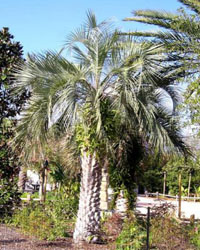Butia capitata - Pindo palm or Jelly palm



Family Arecaceae
Description:
This palm is in the subfamily of the coconut and its seeds have three "eyes" (openings for embryos to emerge) like a coconut. It is native to southern South America and is cold hardy enough to grow into southern Georgia. The trunk will grow to fifteen feet or more in height. Its leaves range from gray-green to blue-gray in color. The orange fruits are fibrous but sweet and edible. The fruits are used to make jelly in the southern United States. The seed kernel yields an edible oil.
Location:
Plants can be seen at the southeast corner of building 2.
Size:
A medium-sized tree with an overall height of twenty feet or more.
Care Instructions:
Light: full sun
Water: drought tolerant when established
Soil: well-drained soil, otherwise no special requirements
This is an easy palm to grow in north Florida. It is reliably cold hardy and tolerant of dry conditions. Old specimens can be found throughout north Florida and southern Georgia. Several species of Butia have been cultivated in Florida. Local variation suggests that hybridization has occurred.
